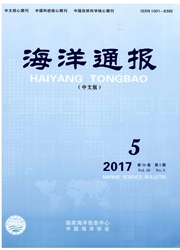

 中文摘要:
中文摘要:
基于ROMS(Regional Ocean Modeling System)模式建立一个南海北部集合最优插值的同化系统,并且利用2008年夏季SCOPE(Northern South China Sea Coastal Oceanographic Process Experiment)航次的温盐数据以及航次期间逐日OSTIA(Operational Sea Surface Temperature and Sea Ice Analysis)数据进行同化试验。试验结果表明:同化较好地改善了海表温度的模拟,加强了南海北部的上升流,尤其是加强了珠江冲淡水的模拟,垂向定量的分析表明,温度整层都得到改善,表层改善达到30%,盐度在80 m以上得到明显改善,表层改善40%。此外,针对近岸卫星SST(sea surface temperature)和航次SST的不协调性问题以及不同观测数量对同化结果的影响,利用敏感性同化试验进行了初步探讨,结果显示:相对于剔除40 m以浅,同化所有区域内卫星SST资料能显著减小近岸区域的SST均方根误差(约51%);加密用于同化的SST数据量,如由每隔5个格点调整为每隔3个格点选取观测数据,也能在此基础上再减小SST的均方根误差(约9.1%),但二者的SST分布形态均与观测吻合。
 英文摘要:
英文摘要:
Based on Regional Ocean Modeling System(ROMS),an Ensemble Optimal Interpolation(EnOI) assimilation system for the northern South China Sea has been developed,The 2008 Northern South China Sea Coastal Oceanographic Process Experiment(SCOPE) cruises data and Operational Sea Surface Temperature and Sea Ice Analysis(OSTIA)are used day by day for assimilation test.The results show that the assimilated result can effectively improve the SST simulation,strengthen the upwelling in this region,and especially improve Pearl River plume simulation.Vertical quantitative analysis shows that the temperature of the whole water column has been improved,to 30% near the surface.And the salinity is significantly improved at upper 80 meters,to 40% near the surface.In addition,for the incompatibility between inshore satellite SST(sea surface temperature) and the cruise SST,and different observation number on the results of assimilation,this paper uses sensitivity assimilation test for preliminary discussion.The results show that,compared to the excluding 40m shallow data,assimilation of satellite SST data in all regions can significantly reduce the root mean square error of inshore region SST(about 51%);Encryption for the SST data assimilation,eg.Select observations from every 5 grid points to every 3 grid points,and RMSE of SST can also be reduced(about 9.1%) on this base.However,distribution patterns of SST are both consistent with the observation.
 同期刊论文项目
同期刊论文项目
 同项目期刊论文
同项目期刊论文
 期刊信息
期刊信息
